 |
| May 16, 2023 | Volume 19 Issue 19 |
Mechanical News & Products
Designfax weekly eMagazine
Archives
Partners
Manufacturing Center
Product Spotlight
Modern Applications News
Metalworking Ideas For
Today's Job Shops
Tooling and Production
Strategies for large
metalworking plants
What's a SLIC Pin®? Pin and cotter all in one!
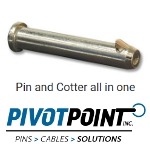 The SLIC Pin (Self-Locking Implanted Cotter Pin) from Pivot Point is a pin and cotter all in one. This one-piece locking clevis pin is cost saving, fast, and secure. It functions as a quick locking pin wherever you need a fast-lock function. It features a spring-loaded plunger that functions as an easy insertion ramp. This revolutionary fastening pin is very popular and used successfully in a wide range of applications.
The SLIC Pin (Self-Locking Implanted Cotter Pin) from Pivot Point is a pin and cotter all in one. This one-piece locking clevis pin is cost saving, fast, and secure. It functions as a quick locking pin wherever you need a fast-lock function. It features a spring-loaded plunger that functions as an easy insertion ramp. This revolutionary fastening pin is very popular and used successfully in a wide range of applications.
Learn more.
Engineering challenge: Which 3D-printed parts will fade?
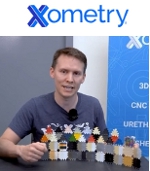 How does prolonged exposure to intense UV light impact 3D-printed plastics? Will they fade? This is what Xometry's Director of Application Engineering, Greg Paulsen, set to find out. In this video, Paulsen performs comprehensive tests on samples manufactured using various additive processes, including FDM, SLS, SLA, PolyJet, DLS, and LSPc, to determine their UV resistance. Very informative. Some results may surprise you.
How does prolonged exposure to intense UV light impact 3D-printed plastics? Will they fade? This is what Xometry's Director of Application Engineering, Greg Paulsen, set to find out. In this video, Paulsen performs comprehensive tests on samples manufactured using various additive processes, including FDM, SLS, SLA, PolyJet, DLS, and LSPc, to determine their UV resistance. Very informative. Some results may surprise you.
View the video.
Copper filament for 3D printing
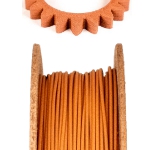 Virtual Foundry, the company that brought us 3D-printable lunar regolith simulant, says its popular Copper Filamet™ (not a typo) is "back in stock and ready for your next project." This material is compatible with any open-architecture FDM/FFF 3D printer. After sintering, final parts are 100% pure copper. Also available as pellets. The company says this is one of the easiest materials to print and sinter. New Porcelain Filamet™ available too.
Virtual Foundry, the company that brought us 3D-printable lunar regolith simulant, says its popular Copper Filamet™ (not a typo) is "back in stock and ready for your next project." This material is compatible with any open-architecture FDM/FFF 3D printer. After sintering, final parts are 100% pure copper. Also available as pellets. The company says this is one of the easiest materials to print and sinter. New Porcelain Filamet™ available too.
Learn more and get all the specs.
Copper foam -- so many advantages
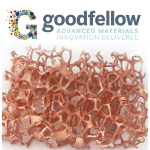 Copper foam from Goodfellow combines the outstanding thermal conductivity of copper with the structural benefits of a metal foam. These features are of particular interest to design engineers working in the fields of medical products and devices, defense systems and manned flight, power generation, and the manufacture of semiconductor devices. This product has a true skeletal structure with no voids, inclusions, or entrapments. A perennial favorite of Designfax readers.
Copper foam from Goodfellow combines the outstanding thermal conductivity of copper with the structural benefits of a metal foam. These features are of particular interest to design engineers working in the fields of medical products and devices, defense systems and manned flight, power generation, and the manufacture of semiconductor devices. This product has a true skeletal structure with no voids, inclusions, or entrapments. A perennial favorite of Designfax readers.
Learn more.
Full-color 3D-printing Design Guide from Xometry
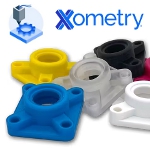 With Xometry's PolyJet 3D-printing service, you can order full-color 3D prints easily. Their no-cost design guide will help you learn about different aspects of 3D printing colorful parts, how to create and add color to your models, and best practices to keep in mind when printing in full color. Learn how to take full advantage of the 600,000 unique colors available in this flexible additive process.
With Xometry's PolyJet 3D-printing service, you can order full-color 3D prints easily. Their no-cost design guide will help you learn about different aspects of 3D printing colorful parts, how to create and add color to your models, and best practices to keep in mind when printing in full color. Learn how to take full advantage of the 600,000 unique colors available in this flexible additive process.
Get the Xometry guide.
Tech Tip: How to create high-quality STL files for 3D prints
 Have you ever 3D printed a part that had flat spots or faceted surfaces where smooth curves were supposed to be? You are not alone, and it's not your 3D printer's fault. According to Markforged, the culprit is likely a lack of resolution in the STL file used to create the part.
Have you ever 3D printed a part that had flat spots or faceted surfaces where smooth curves were supposed to be? You are not alone, and it's not your 3D printer's fault. According to Markforged, the culprit is likely a lack of resolution in the STL file used to create the part.
Read this detailed and informative Markforged blog.
Test your knowledge: High-temp adhesives
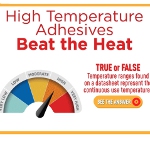 Put your knowledge to the test by trying to answer these key questions on how to choose the right high-temperature-resistant adhesive. The technical experts from Master Bond cover critical information necessary for the selection process, including questions on glass transition temperature and service temperature range. Some of the answers may surprise even the savviest of engineers.
Put your knowledge to the test by trying to answer these key questions on how to choose the right high-temperature-resistant adhesive. The technical experts from Master Bond cover critical information necessary for the selection process, including questions on glass transition temperature and service temperature range. Some of the answers may surprise even the savviest of engineers.
Take the quiz.
Engineer's Toolbox: How to pin a shaft and hub assembly properly
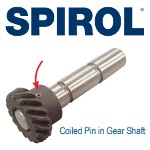 One of the primary benefits of using a coiled spring pin to affix a hub or gear to a shaft is the coiled pin's ability to prevent hole damage. Another is the coiled pin absorbs wider hole tolerances than any other press-fit pin. This translates to lower total manufacturing costs of the assembly. However, there are a few design guidelines that must be adhered to in order to achieve the maximum strength of the pinned system and prevent damage to the assembly.
One of the primary benefits of using a coiled spring pin to affix a hub or gear to a shaft is the coiled pin's ability to prevent hole damage. Another is the coiled pin absorbs wider hole tolerances than any other press-fit pin. This translates to lower total manufacturing costs of the assembly. However, there are a few design guidelines that must be adhered to in order to achieve the maximum strength of the pinned system and prevent damage to the assembly.
Read this very informative SPIROL article.
What's new in Creo Parametric 11.0?
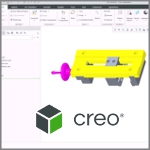 Creo Parametric 11.0 is packed with productivity-enhancing updates, and sometimes the smallest changes make the biggest impact in your daily workflows. Mark Potrzebowski, Technical Training Engineer, Rand 3D, runs through the newest functionality -- from improved surface modeling tools to smarter file management and model tree navigation. Videos provide extra instruction.
Creo Parametric 11.0 is packed with productivity-enhancing updates, and sometimes the smallest changes make the biggest impact in your daily workflows. Mark Potrzebowski, Technical Training Engineer, Rand 3D, runs through the newest functionality -- from improved surface modeling tools to smarter file management and model tree navigation. Videos provide extra instruction.
Read the full article.
What's so special about wave springs?
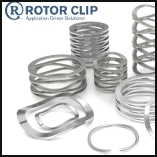 Don't settle for ordinary springs. Opt for Rotor Clip wave springs. A wave spring is a type of flat wire compression spring characterized by its unique waveform-like structure. Unlike traditional coil springs, wave springs offer an innovative solution to complex engineering challenges, producing forces from bending, not torsion. Their standout feature lies in their ability to compress and expand efficiently while occupying up to 50% less axial space than traditional compression springs. Experience the difference Rotor Clip wave springs can make in your applications today!
Don't settle for ordinary springs. Opt for Rotor Clip wave springs. A wave spring is a type of flat wire compression spring characterized by its unique waveform-like structure. Unlike traditional coil springs, wave springs offer an innovative solution to complex engineering challenges, producing forces from bending, not torsion. Their standout feature lies in their ability to compress and expand efficiently while occupying up to 50% less axial space than traditional compression springs. Experience the difference Rotor Clip wave springs can make in your applications today!
View the video.
New Standard Parts Handbook from JW Winco
 JW Winco's printed Standard Parts Handbook is a comprehensive 2,184-page reference that supports designers and engineers with the largest selection of standard parts categorized into three main groups: operating, clamping, and machine parts. More than 75,000 standard parts can be found in this valuable resource, including toggle clamps, shaft collars, concealed multiple-joint hinges, and hygienically designed components.
JW Winco's printed Standard Parts Handbook is a comprehensive 2,184-page reference that supports designers and engineers with the largest selection of standard parts categorized into three main groups: operating, clamping, and machine parts. More than 75,000 standard parts can be found in this valuable resource, including toggle clamps, shaft collars, concealed multiple-joint hinges, and hygienically designed components.
Get your Standard Parts Handbook today.
Looking to save space in your designs?
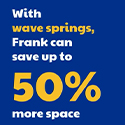 Watch Smalley's quick explainer video to see how engineer Frank improved his product designs by switching from traditional coil springs to compact, efficient wave springs. Tasked with making his products smaller while keeping costs down, Frank found wave springs were the perfect solution.
Watch Smalley's quick explainer video to see how engineer Frank improved his product designs by switching from traditional coil springs to compact, efficient wave springs. Tasked with making his products smaller while keeping costs down, Frank found wave springs were the perfect solution.
View the video.
Top die casting design tips
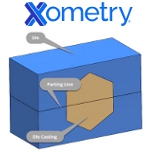 You can improve the design and cost of your die cast parts with these top tips from Xometry's Joel Schadegg. Topics include: Fillets and Radii, Wall Thicknesses, Ribs and Metal Savers, Holes and Windows, Parting Lines, and more. Follow these recommendations so you have the highest chance of success with your project.
You can improve the design and cost of your die cast parts with these top tips from Xometry's Joel Schadegg. Topics include: Fillets and Radii, Wall Thicknesses, Ribs and Metal Savers, Holes and Windows, Parting Lines, and more. Follow these recommendations so you have the highest chance of success with your project.
Read the full Xometry article.
What's the latest from 3D Systems? Innovations for different industries, processes
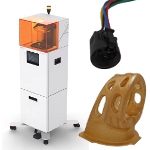 3D Systems unveiled several new solutions at the RAPID+TCT 2025 show in April designed to change the way industries innovate. From new 3D printers and materials for high-mix, low-volume applications to marked improvements in how investment casting can be done, learn what is the state of the art from the original inventors of 3D printing.
3D Systems unveiled several new solutions at the RAPID+TCT 2025 show in April designed to change the way industries innovate. From new 3D printers and materials for high-mix, low-volume applications to marked improvements in how investment casting can be done, learn what is the state of the art from the original inventors of 3D printing.
Read the full article.
Clever! Indexing plungers with chamfered pins
 JW Winco has developed a new type of indexing plunger -- GN 824 -- that can independently latch into edges and grooves. This is made possible by a chamfered plunger pin. When the chamfered pin encounters a raised latching geometry, it retracts and then springs back out again once it reaches the latching point. This new indexing plunger can be ordered with axial thread for fastening and a black plastic knob for operating the indexing plunger. In a clever design, the plunger pin can be adjusted by 360 degrees to ensure that it encounters the mating surface perpendicularly. This hardware is well suited for transport frames, mechanisms, or covers that need to be locked in place quickly and securely, especially without the need for manual intervention.
JW Winco has developed a new type of indexing plunger -- GN 824 -- that can independently latch into edges and grooves. This is made possible by a chamfered plunger pin. When the chamfered pin encounters a raised latching geometry, it retracts and then springs back out again once it reaches the latching point. This new indexing plunger can be ordered with axial thread for fastening and a black plastic knob for operating the indexing plunger. In a clever design, the plunger pin can be adjusted by 360 degrees to ensure that it encounters the mating surface perpendicularly. This hardware is well suited for transport frames, mechanisms, or covers that need to be locked in place quickly and securely, especially without the need for manual intervention.
Learn more.
Unlikely plan is helping the U.S. fast-track hypersonic conventional weapons
An experimental way of doing business could reshape how industry works with a national lab.
Hypersonic weapons have been a top priority for modernizing the armed forces, with ultrafast, long-range, and maneuverable munitions being touted as a revolutionary advance in modern warfare. The U.S. has fast-tracked their development and announced plans to field the first conventional hypersonic missile battery this year. To meet this deadline, some contributing organizations have partnered in unprecedented ways.
Scott Nance, a manager at Sandia National Laboratories, is at the forefront of one such collaboration. He and his team piloted a new way to transfer Sandia's technical designs to defense contractors for the common hypersonic glide body, which detaches from a rocket and soars at speeds above Mach 5.

A March 2020 test of a U.S. hypersonic missile used the common hypersonic glide body designed and built at Sandia National Laboratories. Sandia has partnered with industry to accelerate manufacturing of glide bodies for future deployment. [Credit: Photo courtesy of U.S. Navy]
The program is now earning recognition and could change how Sandia partners with industry in the future.
"Sandia National Labs' successful teaming with the Army, Navy, and industry has been crucial to keeping the services on the path to our nation's first operational hypersonic capability," said Lt. Gen. Robert Rasch Jr., Director, Army's Rapid Capabilities and Critical Technologies Office.
This year, the Federal Laboratory Consortium for Technology Transfer awarded Sandia a national Interagency Partnership Award for its successful transition of hypersonic technology to industry partners.
The plan, Nance said, initially alarmed some people when he proposed it.
"We got a lot of wide eyes to: 'Can we do this?'" Nance said.
New program answers call of a tight timeline
Nance manages a team of experts in transferring technical designs from Sandia to industry. He said that for similar projects, moving plans out of the lab and into manufacturing is a slow and meticulous process of documentation, training, and testing, especially for projects where the designs are very complicated and margins for error are slim.
"We were given three years to take our design, redesign it to meet the Department of Defense's weapon system requirements, make it more producible, get it into production, and get it fielded," Nance said. "It's a time scale that was very hard to meet."
The only way to get the job done, Nance thought, was to bring in outsiders, lots of them, which seemed to break every rule of a national security lab.
One does not simply walk into a national security lab
As a research and engineering lab born with the atomic bomb, Sandia prioritizes security. Its researchers work on a wide range of sensitive national security projects, including nuclear weapons modernization, critical infrastructure protection, and homeland security. Sandia is primarily located on Kirtland Air Force Base. Information is carefully protected, and access is controlled.
Sandia commonly grants access to subcontractors who pass a vetting process to assist with these projects, but Nance proposed something new. He wanted to bring in dozens of the Army's contractors, who had no agreement with Sandia, and provide them with access to Sandia equipment and resources so they could build the advanced flight systems side by side with Sandia subject matter experts.
Nance said he is unaware of any program that has brought in so many uncontracted visitors to work at Sandia. Though the idea surprised many of his colleagues, Nance and his team developed a plan that satisfied management and security specialists at the labs.
Companies and individuals would need to sign safety and security agreements. Guests would complete the same training as regular employees, from counterintelligence awareness to safety and ethics. Department of Defense security clearances would be verified.
Sandia's Heather Sandoval, an information management professional on Nance's team who helped hatch the plan, hosted on-site onboarding for classification briefings and facility tours after partners completed online training.
In 2019, the first class of 14 industry partners reported to Sandia for training. Within six months, the total number grew to 138.
"The second wave was more manageable with the new onboarding process, even though the class size increased dramatically," Sandoval said.
A new path forward for partnering with industry
At its height, Sandia had trained a total of around 200 partners and was hosting workers from seven companies, including Dynetics, the Army's lead manufacturing contractor for the common hypersonic glide body. As many as 50 partners were on site at a given time.
Alex Roesler, a Sandia senior manager involved in hypersonic weapon development, said, "Sandia's facilities team was instrumental in helping us quickly get space configured -- lab and office space -- to support the work and provide places for these partners to work."
The payoff was visible as visitors and staff formed a powerful camaraderie.
"What was most memorable to me was seeing all these companies coming together in one space sharing their expertise," Sandoval said. She was amazed at the mix of managers, technologists, administrators, engineers, and others from different companies who filled their daily 8 a.m. team meetings.
"They built Sandia flight hardware side by side with us, learning our culture, learning our language, learning our design and our drawings, and then they were able to take the information back to their companies," Nance said.
By the end of 2022, Sandia's industry partners had produced its first flight system. Collaboration at Sandia is ongoing, but components for hypersonic glide bodies are now being produced at facilities around the country.
"We have the knowledge and the expertise. Now it's our turn to pass the baton to another company for production," Sandoval said.
The success of the program could change how Sandia approaches technology transfer projects in the future. Sandoval said she has been contacted by other programs that want to learn how her team used industry partners, and Nance said he and his management are evaluating how to adapt the pilot to other programs.
"I absolutely think this is the model for future programs," Nance said.
Source: Sandia National Laboratories
Published May 2023
Rate this article
View our terms of use and privacy policy

